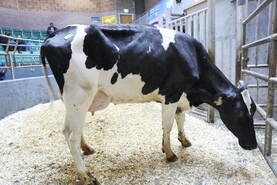There’s a real feel of winter about the yard now with most sheds occupied. With the exception of a few cows out to tidy up the silage ground across the road, everything is housed.
Weaning has almost been completed and at this stage all that remains on a cow is the youngest calf. She’ll probably stay on the cow until close to when the heifer weanlings can get out to grass next spring.
The last of the bull weanlings got their introduction to meal on Monday. They’re only behind their comrades by just over a fortnight in terms of getting extra feed.
Just like fertiliser use throughout the year, ration will have to be justified and when it comes to bulls, I have less hesitation feeding them on compared to the other classes of stock due to their ability to convert the feed into weight gain.
The ration price for them has risen by one third on this time two years ago and back then it was considered expensive, but with a limited land base it’s difficult to look beyond this system. It might be seen as a foolish move by some but I can’t overlook their efficiency in comparison to bullocks.
Since we began finishing bulls, there’s been a few subtle tweaks to the system
At the moment, there’s a pair of smaller heifer calves being fed daily along with the bulls while the remaining heifers might get a small bit once a week. Other than that, it will be a silage and grass lifestyle for them. The only other stock being fed for now are the remaining cull heifers and a few cull cows that aren’t far from going. The culls in lesser condition will go to grass as soon as the opportunity arises in 2023.
Since we began finishing bulls, there’s been a few subtle tweaks to the system. Straw used to replace silage for the final 50 to 70 days in the early years of finishing bulls but now silage is kept in the mix for the entire finishing period and, as a result, it shaved a good bit off the ration bill.
Hereford sire
This year, almost half of the bull weanlings are from a Hereford sire so it’s going to be interesting to see how they finish out and what level of meal will see them finished.
When we tried them in other years invariably they were among the first bulls to go each year and their fat scores and grade were where I’d like them to be.
The move to using traditional breeds was initially driven by too high a percentage of cattle not getting the quality assurance (QA) bonus by not attaining a fat score greater than 2+. It was a case of hold for longer and feed more ration or breed in fleshier stock.
In recent years, cost increases have become a driver of that change too, both in terms of time to finish and associated labour. It’s early days in the experiment yet but I need to weigh up whether to cross continentals back on the heifers as they become mature cows or stick with the traditional breeds in the long term.
Another reason for going this route was if bulls were no longer an option then Angus or Hereford would surely have a better chance of being finished from grass as bullocks ahead of a second winter in the shed.
That’s all ifs, buts and maybes, at this stage but for now I’ll keep things as similar to the last few winters if I can.






 This is a subscriber-only article
This is a subscriber-only article











SHARING OPTIONS: